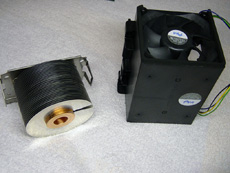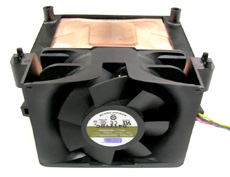Intel's Long Awaited BTX Form Factor
by Purav Sanghani on November 15, 2004 5:31 AM EST- Posted in
- Cases/Cooling/PSUs
BTX Cooling and Airflow
Again, the main reasoning behind Intel during the redesign of the ATX form factor was to design a more efficient cooling solution. As components are built faster they also run hotter. The ATX form factor improved on the AT specifications by placing the CPU closer to the back of the case where fans could be mounted as exhausts to pull hot air from the CPU out of the chassis and away from other components. Now that those other components in PCs are beginning to expand in performance and functionality they are running at temperatures as high as that of CPUs so a new design needed to be devised to help cool these components in a more efficient manner than just slapping more fans in a standard case. Now, we have come full circle with the CPU moving back towards the front of the case. Since Intel has the standards on PCIe very heavily controlled, worrying about PCIe cards extending too far to the front of the case should not be a problem.Intel implements a more efficient passive cooling system by placing the majority of components inline with the CPU towards the rear of the chasis.
 Click to Enlarge |
 Click to Enlarge |
The most important piece of hardware when it comes to cooling is the CPU heat sink fan. Without this a CPU would not POST, and would most likely damage the hardware. Intel has included what it calls a "BTX Thermal Module" which consist of either a spiral or stacked-fin heatsink and a fan which is mounted at the end of a plastic duct, facing the front end of the case. Intel has not limited this hardware to only one type though. In their virtual press kit Intel speaks of Type I (Standard height) and Type II (Low profile) thermal modules. The Type I module will be designed for a broader range of cases from small form factor to the larger full tower applications while the Type II module will be designed specifically for the ultra-small form factor designs.
 Click to Enlarge |
 Click to Enlarge |
Intel also mentioned that along with those two types of thermal modules there will be variations in the units for processors rated at different Thermal Design Power, or TDP levels. The difference in modules will exist mainly with the heatsink, with slight variations in the duct. The fan will, however, remain the same within the same type (Type I/Type II) of module.
This thermal module was the only piece of cooling hardware aside from the power supply which we found to be surprising. We couldn't imagine running an ATX case with only one CPU heatsink fan and we have our doubts about Intel's single module design, but we will leave that to our benchmarks to decide.










77 Comments
View All Comments
trikster2 - Tuesday, November 16, 2004 - link
I've got to say, this review is bad, even by anandtech standards.
Comparing an mBTX destop to a mATX TOWER to a Fullsize ATX desktop, litteraly comparing apples to oranges to pears, and then coming to sweeping conclusions like "any of us were skeptical for a long time, but after seeing the numbers ... we can conclude that BTX is not hype. " is simply ludicrouse.
Shame on you anand for letting such a review fall through your QC into the hands of the general public.
I'm not sure if you guys are incompetent or payed by intel to find a combo to pimp the BTX standard. I just did a refresh 5 times, no intel adds so it must be the former.
How about spending 49.95 on a decent desktop mATX case and compare apples to apples, instead of just grabbing whatever was laying around the lab (we've seen that whacked oppus case in other reviews haven't we?)?
I have the silverstonetek equivalent of the oppus matx tower. It is the worst mATX cases I have ever worked with. Give us a break and do a valid review, mATX single fan 1/2 height desktop to mBTX single fan 1/2 height desktop.
johnsonx - Tuesday, November 16, 2004 - link
I see nothing here in the BTX standard that couldn't have been better accomplished with a backwards and forwards compatible ATX II standard.ATX II compliant motherboards would have standardized locations for the CPU socket, two standard locatations for RAM (either or both locations could be used, as needed), standard locations for the power connectors, standard locations for the most common onboard ports (IDE, SATA, front USB, audio, etc.) and standard component heights (capacitors and etc.).
ATX II compliant cases would have standardized air intake and exhaust locations, fan mounts, and ducting. ATX II cases could be built to open from the right side, with the CPU on the bottom. The ducting would be removeable for use with a legacy ATX mainboard.
ATX II compliant heatsinks would be fanless, designed to be cooled by an ATX II chassis duct, but would have a fan mounting point for use in a legacy ATX chassis. Boxed coolers that come with retail CPU's would include the fan on a standard clip with instructions to remove it when used with an ATX II compliant chassis and mainboard.
ATX II compliant power supplies would basically be the same as the latest ATX supplies are now - 24pin power, 8-pin ATX 12v power, standard 4-pin drive power plugs, SATA power plugs, PCI-E graphics power plug. 24 to 20 pin converters and 8-pin to 4-pin converters would be standard with retail power supplies.
Any mix of ATX and ATX II components would work fine together, but a system built of all ATX II components would gain various cooling, noise level, assembly and operational advantages.
What does BTX offer that my hypothetical ATX II standard doesn't? Oh, yeah... ATX II couldn't give you a face of hot air...
xsilver - Monday, November 15, 2004 - link
To the guy b4 that was wondering where the air intakes are -- no amount of case fans are going to create a vacum inside your case, there's just not enough pressure -- unless you tape up all the gaps lol.... so the air will just "flow" in from any holes in your caseblackmetalegg - Monday, November 15, 2004 - link
Bah we're(work) using this motherboard in an application that shall remain anonymous(NOT oridinary PC) and the damn design make wiring a bitch to deal with. And the motherboard isn't all that stable, considering it's from Intel...justly - Monday, November 15, 2004 - link
BTW that 20.666715 "cfm" is assuming all of the area taken by the 2 fans has air flow, but we should all knoe that the motor and frame ocupy some of that space so the actual "cfm" would be lower.justly - Monday, November 15, 2004 - link
Why was "lfm" not converted to "cfm" for a direct comparison on page 11?If I am reading this correctly the BTX provides 40 "cfm" while the ATX requires 150 "lfm". This sounds like BTX is an overwhelming success, untill you do the conversion that is. So what exactly does this 150 "lfm mean in comparison, well if the ATX uses 2-80mm fans that would be 80mm x 80mm = 6400 square mm per fan, 6400 x 2 = 12800 square mm for both fans, convert that to square ft and you get 0.1377781 square ft, take that and multiply by the 150 "lfm" and we get (drum roll) 20.666715 "cfm". Thats right about half what the BTX has.
I don't know if this was intentional or not, but I will give the author the benifit of the doubt and assume it was not.
If I have overlooked something please explain my mistake, if not then I feel some injustice has been done to the readers that did not ask this question.
ShadowVlican - Monday, November 15, 2004 - link
like someone else said... the BTX form wasn't made for enthusiasts, since we already know how to cool our rigs properly..BTX is for the average consumer who doesn't know jack about computers, so BTX will help those people have quieter/cooler computers without them reading forums/articles
i'm just wondering how well the transition from ATX machines into BTX will go...
ZobarStyl - Monday, November 15, 2004 - link
Yes Five40, you can't directly upgrade from 754 to 939, but you can take your case and PSU with you...I'm using the same case I used in my AXP system now for an A64 with watercooling, but if Intel has their way, my next rig won't be able to use the same rig and I'll just have to spend more cash. Hence, we are rightfully pissed because the real question is "Why?" and when something lacks benefits but costs you mad cash: a whole new case and good PSU will set me back 120 bucks, for what? Nothing worth my time.MAValpha - Monday, November 15, 2004 - link
Anyone know how pBTX stacks up against FlexATX?five40 - Monday, November 15, 2004 - link
#50....umm I can't do a A64 to A64 upgrade so what's your point? 754 to 939 does me no good. I just see this as another socket update. A64 might not need it right now, but if all things where just made for what we need right now, we'll move forward at a very slow pace.